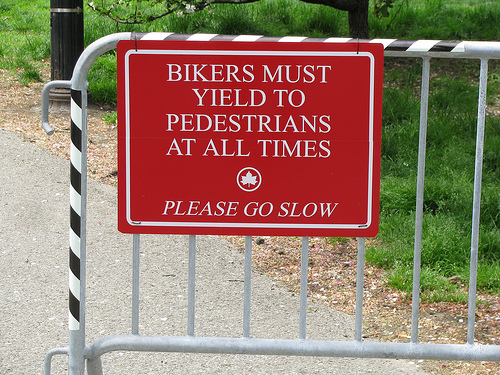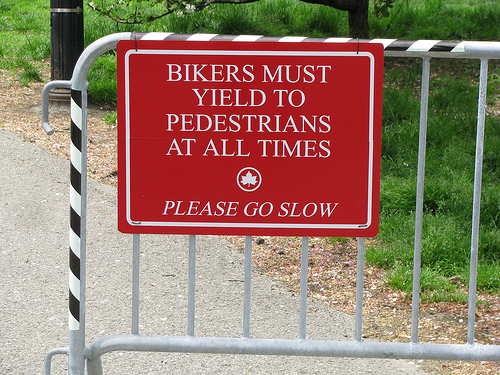 Shared-use paths result in inevitable conflict between cyclists and pedestrians.Photo: Bryan GoebelLast month, a young woman was jogging along the popular new Katy Trail in Dallas, Texas, wearing headphones. She turned left and was struck by a woman on a bicycle. The jogger’s head hit the pavement. Several days later, she died.
Shared-use paths result in inevitable conflict between cyclists and pedestrians.Photo: Bryan GoebelLast month, a young woman was jogging along the popular new Katy Trail in Dallas, Texas, wearing headphones. She turned left and was struck by a woman on a bicycle. The jogger’s head hit the pavement. Several days later, she died.
The Katy Trail is not a trail in the woods, but a multi-use path, or, in planning-speak, a “MUP.” These paved byways are varyingly called trails, paths, rail trails, bike trails, or linear parks. The mix of terminology reflects the current confusion about what exactly they are for.
The original concept is that of the linear park — a destination in the city or suburbs where locals of all ages can go get fresh air and exercise in a natural setting. Mellow recreation was the idea. The bicycle has always been part of this mix. But MUPs aren’t always simply about recreation. The use of these paths as transportation corridors, rather than parks, is being pushed increasingly at a local level, and even promoted by the feds, including in a recent interview with U.S. Department of Transportation Secretary Ray LaHood on this site.
But there’s a disconnect between the speedy reality of bicycle transportation and the slow, recreational uses these trails are designed for. Multi-use paths are only required to be eight feet wide. That’s fine for a stroll in the park, but when you factor in two lanes for bikes as well as joggers, skaters, and roving families, it’s alarmingly narrow.
Most planning guidelines acknowledge that a 10-foot trail width is better, and recommend 12 for areas with heavy bicycle traffic. Even that — as we learned on the Katy Trail, which is still being built to these state-of-the-art standards and even includes a narrower, supplemental trail for walking — isn’t enough when bikes are in the mix.
It should be no surprise that these paths see a high collision and injury rate. A 2009 literature review of traffic safety studies looked at bicycle crashes and discovered that multi-use paths are more dangerous to ride on than even major roads.
Most attempts to address the danger focus on educating users to “share the path.” This has been the gist of the most levelheaded responses to the tragic incident on the Katy Trail.
In effect, this is a way to blame the users. This becomes more clear when you brave the comment section on any story about the tragedy. The vitriolic finger-pointing starts immediately. Some blame bicyclists who ride fast and don’t use their bells when passing. Others blame walkers and joggers who stop suddenly, don’t hold their line, and let their kids and dogs run freely. Everyone blames people wearing headphones. Some simply blame everyone.
Meanwhile, few are looking to the real culprit: the increasingly common practice of building transportation facilities that cannot safely or comfortably carry the planned types of traffic, promoting them heavily, and then accepting easy credit for providing bike routes without having to take the political risks of encroaching on the vast amounts of roadways reserved for cars.
Shared trails are being heavily funded on the federal level, with politicians and advocates claiming major bike-friendliness points. This trend is likely to continue even post-election — Rep. John Mica (R-Fla.) in line to be the new chair of the House Transportation Committee, is already boasting that his state has the most such multi-use paths in the country.
Even if they were not shared, many of these paths would not be adequate for bicycle traffic. Sight lines are not good, there is often no lane to pass slower riders, and the number of users keeps going up, up, and up. This is not the fault of people who ride bikes on them. In most cities, as in Dallas, options are slim. A congested, shared off-road path is often the lesser of two evils.
Politicians, planners, and advocates need to step up. And disgruntled trail users need to stop blaming each other and demand real bike paths. Often there’s room in the same right of way to have a walking path and bike lanes in both directions, all wide enough. Many cities are experimenting with these, including Vancouver, B.C., Manhattan, and Seoul — though you can still see an inevitable amount of user error in each of these photos.
But a few token separated paths, no matter how wide, will never be more than a political compromise. We need suitable places to go walk and jog and relax.
And if we are going to fill the rapidly growing demand for bicycle infrastructure, we need the real thing. Cramming bikes onto serene paths is like putting a superhighway through a schoolyard.
We already have a wide-ranging network of paved bike routes, where people can ride as fast and freely as they need to, have plenty of room to pass each other, and can expect to encounter pedestrians and joggers at clearly marked intersections. We just need to take back some of that space from cars. And for the sake of the paths, we need to do it soon.



